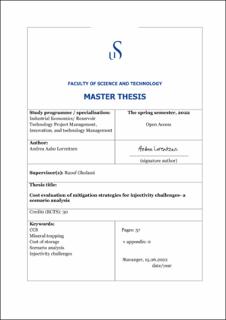| dc.description.abstract | Global warming is a key concern for human society and anthropogenic emissions must be reduced. To aid this development, carbon capture and storage has showed a great potential. Here, carbon dioxide is captured and stored in geological formations. Until now, economic profitability of this technology has been limited to the oil and gas industry. Here, the CCS technology is more easily implemented as the investment and operating cost can be justified with the high carbon dioxide tax, infrastructure and reservoir knowhow. Outside of the hydrocarbon industry, the startup phase of any CCS project will require high initial investment in regard to capture facilities, transporting infrastructure, terminal and storage sites. To compensate for these expenditures, substantial volumes of CO2 must be injected into the subsurface. The Northern Lights project is the world’s first full scale carbon capture and storage development with third-party customers. In this large-scale project profitability will be generated by obtaining a high injection rate. To ensure technical feasibility, multiple geological studies have been performed; however, CO2 has not yet been injected into the formation. Therefore, the possibility of unforeseen geological events rises. When CO2 is injected to the storage site, geochemical interactions are imposed. The reactions can alter the rock properties, causing lower injection rates. Experience from CCS operations like the Norwegian Snøhvit and Sleipner project, which were salt precipitated and sand influx respectively, has proven that geochemical interactions can have fatal consequences.
In this thesis three different scenarios are developed to investigate the economic outcomes of injectivity reduction in the storage formation of the Northern Lights project. The scenarios are build based on previous injectivity challenges, and geochemical simulations. The simulations were performed using the PHREEQC software to model the behaviour of different mineral in the Aurora formation. Simulation showed a large amount of calcite precipitating that can potentially clog the wellbore region. Moreover, to calculate the economic outcomes a pre-tax present value analysis with data from open access sources was performed. The scenarios investigated in this study shows that a 10 % reduction in well injectivity increases storage cost with 51 % whereas in scenarios where mitigation measures are conducted the cost increase is between 4-30 %. This thesis indicated that preparing for injectivity problems is more favourable in terms of limiting the cost of storage, although upfront investment of mitigation measures might seem substantial. | |
